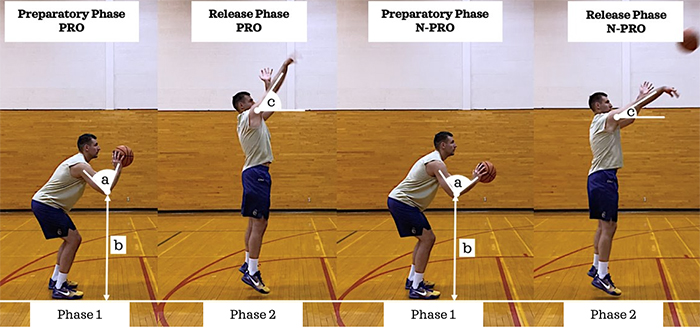Study photographically identifies characteristics that make proficient basketball scorers

LAWRENCE — Anyone who’s ever shot a basketball has heard a coach or well-meaning bystander give them tips like “bend your knees,” “tuck your elbow in” or “release the ball as high as possible.” A new series of studies from the University of Kansas examined which of those commonly implemented coaching cues can actually classify which basketball shooters are proficient and which are not.
“There are as many coaching cues as there are coaches, but there is a lack of scientific literature focused on examining their effectiveness as well as which cues can actually elicit notable improvements in shooting performance,” said Dimitrije Cabarkapa, director of basketball research at KU’s Jayhawk Athletic Performance Laboratory, part of the Wu Tsai Human Performance Alliance.
Among the study co-authors were Andrew Fry, professor of health, sport & exercise science and director of the Jayhawk Athletic Performance Laboratory; Michael Deane, a New York State Basketball Hall of Fame inductee with a 506-365 record in collegiate coaching and Cabarkapa’s former coach at James Madison University; John Poggio, professor of educational psychology and research at KU; Damjana Cabarkapa, doctoral student and graduate teaching/research assistant in the Jayhawk Athletic Performance Laboratory; and Kevin Carlson, assistant professor of biology at Drake University.
The first study, published in the Journal of Applied Sport Sciences, utilized high-definition video analysis to examine kinematic difference between proficient and nonproficient free-throw shooters. The findings indicated that lower elbow placement attained by greater flexion in the hip, knee and ankle joints during the preparatory phase of the shooting motion may help basketball players to improve their free-throw shooting performance. Interestingly, no difference in the kinematic parameters observed in this study was found between made and missed free-throw shots within a proficient group of shooters, which led the researchers to conduct a follow-up investigation.
In a second study published in the Central European Journal of Sport Science and Medicine, Cabarkapa and colleagues used a three-dimensional motion capture system to obtain additional insight into some of the key kinematic parameters of the free-throw shooting motion, primarily forearm positioning, referred to as lateral elbow deviation. Greater knee and elbow flexion, as well as lower elbow placement, were found to be characteristics of proficient free-throw shooters, which is in agreement with the findings of the preceding study. In addition, proficient shooters were also capable of positioning the forearm as close to parallel with an imaginary vertical axis, or less lateral elbow deviation. This was also found to be the only significant difference between made and missed free-throw shots within the proficient group of shooters.
While coaches and fans may repeat the aphorism that free throws win games, there are other types of shooting motions that lead to scoring opportunities. Good basketball players also need to possess solid two- and three-point shooting capabilities. A third study, recently published in the Sports research journal, examined differences in kinetic and kinematic characteristics between proficient and nonproficient two- and three-point shooters, as well as the influence of the shooting approach, such as stationary versus a step-in approach. Cabarkapa and colleagues used high-definition video analysis and a force plate system to derive shooting performance variables of interest. The results indicated that, unlike observed for the free-throw shooting motion, proficient two-point shooters had greater elbow placement and greater elbow flexion during the preparatory phase of the shooting motion while also being able to attain greater shoulder flexion at the time point of the ball release, or a greater release angle. By focusing on these three variables, proficient two-point shooters can be correctly classified from nonproficient in 62% of cases. On the other hand, proficient three-point shooters during the preparatory phase of the shooting motion had greater elbow flexion, such as seen for two-point shooting motion, and kept the torso more erected in a near-vertical position. Also, proficient three-point shooters were capable of achieving greater vertical jump heights at the time point for the ball release. When combined, the three variables were capable of correctly classifying proficient from nonproficient three-point shooters in 82% of cases. In addition, no difference was found in kinetic variables such as peak concentric force or rate of force development, of interest and between stationary and step-in approaches examined in the study.
The studies are just a part of a growing body of scientific literature coming from the Jayhawk Athletic Performance Laboratory. Preceding research has focused on examining the importance of lower body strength and power for future success in professional men’s basketball, the relationship between breakfast consumption and basketball shooting performance and what happens in muscles when overtrained.
“There’s an old coaching saying, ‘It’s easier to teach someone how to properly shoot a basketball than correct bad habits,’” Dimitrije Cabarkapa said. “Therefore, by implementing some of the findings obtained in the previously mentioned studies, coaches may be able to help basketball players to develop a proper shooting technique from a young age. These studies represent only a couple of small pieces of a large puzzle pertaining to optimal basketball shooting performance. Our future research directions are focused on examining biomechanical characteristics of women’s basketball players as well as the acute influence of resistance exercise, presence of a defender, fatigue and sleep on shooting accuracy, and mechanics.”